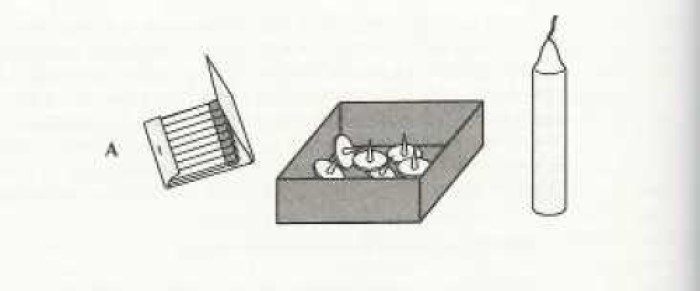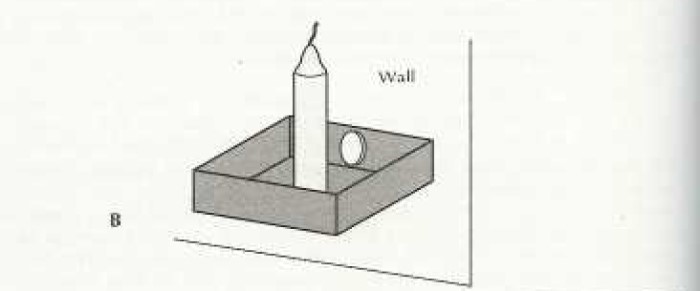Autonomy, Mastery, Purpose: This is How to Motivate Others!
Let’s start this Prime Your Pump blog post with a little trivia. What do Gmail, Google Maps, Google News, Google Translate and Post-It Notes all have in common? I’ll give you a clue, they are related to one of these 3 words: autonomy, mastery, purpose.
Ok, While You Are Pondering That…
I have a problem for you to consider, followed by a question.
Yup, I am full of questions today!
I am going to give you 3 objects: a box of thumbtacks, a candle, and some matches.

Your job is to figure out how to use those 3 objects to attach the candle to a wall.
Any idea how you would do it?
One more question, last one I promise, then no more questions!
Do you think it would help you solve the problem faster if I added some type of incentive, such as giving you a reward such as money?
Ok, Before We Go Any Further…
Here is the solution to the candle problem. You will need to wait for the answer to the Google and Post-It notes question from the introduction.
The solution is to empty the box of thumbtacks, and then to use one of the thumbtacks to fasten the box to the wall and then put the candle inside the box as shown below:

There is a Method to My Madness!
The candle problem is a famous one created in 1945 by a psychologist named Karl Duncker. It has been used in many experimental studies in behavioral science. The problem necessitates your overcoming a phenomenon called functional fixedness. In other words, many people view the box simply as a device to hold the thumbtacks. The key is to be creative and come up with another function for the box, which is a platform to hold the candle.
Now that we understand that you need creativity to solve the problem, let’s connect the dots and address the second question I asked you. I asked you if you thought you could solve the problem faster if I incentivized you with a reward such as money.
In His TED Talk, “The Puzzle of Motivation”
Bestselling author Daniel Pink discussed how a researcher from Princeton named Sam Glucksberg used the candle experiment to demonstrate the power of incentives.
He had 2 groups.
In the first group, he told them he was going to time them to see how long it took them to solve the problem. He explained he was timing them merely to get an understanding of how long it took the average person to solve it.
With the second group, he told them if they were in the fastest 25%, they would be given a $5 reward. And if they were the fastest overall, they would be given a $20 reward.
If You Are Wondering How Much Faster the 2nd Group Solved the Problem…
That’s not how it went down!
Incredibly, the group who was offered an incentive took 3.5 minutes LONGER than the first group!
You would think that if you want people to work faster all you need to do is offer them some type of extrinsic reward, right? WRONG! It turns out that incentives do not increase creativity and focus your thinking, instead they block your creativity and impair your thinking.
If you saw Howie’s recent video on not believing everything you read, he cautioned against believing results from empirical research. In this case, however, the results are not an aberration as they have been replicated over and over for almost 40 years!
But, Hang On, There is One More Thing We Need to Discuss…
The experiment was done in a different way by Dr. Glucksberg. Instead of giving them the matches, candle, and box of thumbtacks, he gave them the matches, candle, and the thumbtacks and box separately.
Now it was obvious to the subjects that the box was part of the solution which eliminated the need for creativity. In this experiment, the incentivized group performed better than the first group.
What Does This All Mean?
What this all means is this – incentives or rewards do work in some circumstances. However, for a lot of tasks, they don’t work at all, and in many cases, they can actually do harm!
External rewards can work well for routine, ruled based tasks that don’t need a lot of creativity.
But for jobs that require conceptual or cognitive skills and creativity, those external rewards can narrow our focus and be counterproductive.
According to Pink in his TED Talk, “What’s alarming here is that our business operating system — think of the set of assumptions and protocols beneath our businesses, how we motivate people, how we apply our human resources– it’s built entirely around these extrinsic motivators, around carrots and sticks. That’s actually fine for many kinds of 20th-century tasks. But for 21st-century tasks, that mechanistic, reward-and-punishment approach doesn’t work, often doesn’t work, and often does harm.” 1
Ditch the Carrot and Stick
Many of the jobs that were previously conducive to incentives or rewards have been automated or outsourced – think computer programming, financial analysis, and certain factory jobs to name a few.
The problem is that there is still a disconnect between what we know about motivation and what most businesses still do.
The key to motivation for those who need to be creative and use their cognitive skills is to utilize autonomy, mastery and purpose.
How to leverage autonomy, mastery, purpose
According to Pink, “The good news is that the scientists who’ve been studying motivation have given us this new approach. It’s built much more around intrinsic motivation. Around the desire to do things because they matter, because we like it, they’re interesting, or part of something important.” 1
He offers three elements of intrinsic motivation that can be leveraged for jobs that require creativity and other cognitive skills: autonomy, mastery, purpose. Using these 3 elements can help you ignite people’s intrinsic fire:
Autonomy – being able to direct our own lives and have some control over what we do.
Mastery – having the opportunity for improvement.
Purpose – being part of something that we are connected to.
Let’s look at a few specific ways that we can use to light people’s intrinsic fire using autonomy, purpose, mastery.

Autonomy – How to Establish It…
Consider giving employees some autonomy over time, technique, task and team while ensuring they are still accountable. It’s a delicate balancing act, but it can be done. Some ideas are:
 Time: flexible hours or working from home.
Time: flexible hours or working from home.
 Technique: instead of telling people exactly what to do, let them know what you need to be done and leave the ‘how’ to them.
Technique: instead of telling people exactly what to do, let them know what you need to be done and leave the ‘how’ to them.
 Task: giving employees the option of working on projects that interest them.
Task: giving employees the option of working on projects that interest them.
 Team: giving employees freedom of who they work with.
Team: giving employees freedom of who they work with.
Mastery – How to Establish It…
Mastery is all about giving people an opportunity to make progress in their work and have an opportunity to get in the flow state. Some things you can do are:
 Give them tasks that aren’t too easy (they will get bored) and aren’t too difficult (they may give up). Challenge them just outside their comfort zone.
Give them tasks that aren’t too easy (they will get bored) and aren’t too difficult (they may give up). Challenge them just outside their comfort zone.
 Make sure they have clear goals and objectives.
Make sure they have clear goals and objectives.
 Ensure they receive timely feedback.
Ensure they receive timely feedback.
 Keep things fresh by adding new challenging tasks.
Keep things fresh by adding new challenging tasks.
Purpose – How to Establish It?
There are a few ways to utilize purpose to create intrinsic motivation:
 Make sure the mission is clear.
Make sure the mission is clear.
 Show them how what they are doing is contributing to the overall mission.
Show them how what they are doing is contributing to the overall mission.
 Explain why things need to be done.
Explain why things need to be done.
Back to Our Trivia Question from the Introduction…
The question again, what do Gmail, Google Maps, Google News, Google Translate and Post-It Notes all have in common? The clue I gave you was that they are related to one of these 3 words: autonomy, mastery, purpose.
The Answer?
Many companies, including 3M (in the mid-20th century) and Google, give their employees the autonomy to work on any project they want. In Google’s case, it is 20% of their time and has led to such famous products as Gmail, Google Maps, Google News, and Google Translate amongst others. In 3M’s case, it led to Post-It Notes.
Until next time, leverage the concept of autonomy, mastery, purpose in intrinsic motivation, and as always…PYMFP!
–Rick
Use It or Lose It
To increase people’s levels of intrinsic motivation, use autonomy, mastery, purpose strategies as we just discussed.
When to Use It:
Use autonomy, mastery, purpose when you want to increase intrinsic motivation for tasks that require creativity and other cognitive skills.
What Do You Think?
Have you used any of these ways to increase people’s intrinsic motivation using autonomy, mastery, purpose? Please share in the comments below!
If you enjoyed this post, it would mean the world to us if you shared it with people you care about via any of the social media platforms below!
Popular Previous Posts:
This is How to Zone Out!
13 Non-Primitive Gym Etiquette Tips from a Caveman!
Public Speaking Nervousness: 8 Tips to Manage Your Anxiety
This is How to Use Tactical Empathy to Negotiate Better!
How to Use the 4 Stages of Competence to Learn New Skills
References
1 The puzzle of motivation – https://www.ted.com/talks/dan_pink_on_motivation/transcript?language=en
Pink, D. H. (2009). Drive: The surprising truth about what motivates us. New York, NY: Riverhead Books.


It all makes good sense! Thanks Rick
Hi Eileen, There’s no doubt about it, it definitely makes sense and works. Thanks, Rick
I developed another method of attaching the candle to the wall before reading your way of doing it. Light the candle, then let hot wax drip onto the heads of three thumbtacks, one at a time. Push the head of the tack into the side of the candle, let the wax dry, and the tack will stick to the candle.
Repeat twice more, lining up the points of the tacks vertically facing outwards. Push the candle into the wall, and it will stay.
Admittedly, your method appears more elegant and safe as it keeps the flame farther from the wall. But then you did not specify safety parameters. However, there are all these un-boxed loose tacks rolling around the floor that someone might step on.
Hi Dave, there you go! Good idea! Be good, Rick